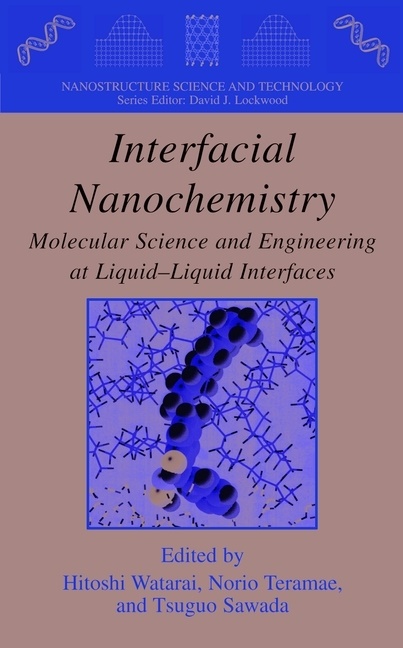Share
Fr. 189.00
Tsugo Sawada, Nori Teramae, Norio Teramae, Hitoshi Watarai
Interfacial Nanochemistry - Molecular Science and Engineering at Liquid-Liquid Interfaces
English · Paperback / Softback
Shipping usually within 6 to 7 weeks
Description
The history of the liquid-liquid interface on the earth might be as old as that of the liquid. It is plausible that the generation of the primitive cell membrane is responsible for an accidental advent of the oldest liquid interfaces, since various compounds can be concentrated by an adsorption at the interface. The presence of liquid-liquid interface means that real liquids are far from ideal liquids that must be miscible with any kinds of liquids and have no interface. Thus it can be said that the non-ideality of liquids might generate the liquid-liquid interface indeed and that biological systems might be generated from the non-ideal interface. The liquid-liquid interface has been, therefore, studied as a model of biological membrane. From pairing two-phases of gas, liquid and solid, nine different pairs can be obtained, which include three homo-pairs of gas-gas, liquid-liquid and solid-solid pairs. The gas-gas interface, however, is practically no use under the ordinary conditions. Among the interfaces produced by the pairing, the liquid-liquid interface is most slippery and difficult to be studied experimentally in comparison with the gas-liquid and solid-liquid interfaces, as the liquid-liquid interface is flexible, thin and buried between bulk liquid phases. Therefore, in order to study the liquid-liquid interface, the invention of innovative measurement methods has a primary importance.
List of contents
Second Harmonic Generation at Liquid/Liquid Interfaces.- Vibrational Sum-Frequency Spectroscopic Investigations of Molecular Interactions at Liquid/Liquid Interfaces.- Observation of Dynamic Molecular Behaviour at Liquid/Liquid Interfaces by Using the Time-Resolved Quasi-Elastic Laser Scattering Method.- Direct Force Measurement at Liquid/Liquid Interfaces.- A Molecular Theory of Solutions at Liquid Interfaces.- Electrochemical Processes at Aqueous/Organic Solution or Aqueous/Membrane Interfaces.- Electrochemical Instability at Liquid/Liquid Interfaces.- Electron Transfer at Liquid/Liquid Interfaces.- Mass Transfer and Reaction Rate in the Nano-Region of Microdroplet/Solution Interfaces.- Single Molecule Diffusion and Metal Complex Formation at Liquid/Liquid Interfaces.- Molecular Recognition of Ions at Liquid/Liquid Interfaces.- Photochemistry at Liquid/Liquid Interfaces.- Development of Surfactant-Type Catalysts for Organic Synthesis in Water.- Bioseparation Through Liquid-Liquid Interfaces.
Summary
The history of the liquid-liquid interface on the earth might be as old as that of the liquid. It is plausible that the generation of the primitive cell membrane is responsible for an accidental advent of the oldest liquid interfaces, since various compounds can be concentrated by an adsorption at the interface. The presence of liquid-liquid interface means that real liquids are far from ideal liquids that must be miscible with any kinds of liquids and have no interface. Thus it can be said that the non-ideality of liquids might generate the liquid-liquid interface indeed and that biological systems might be generated from the non-ideal interface. The liquid-liquid interface has been, therefore, studied as a model of biological membrane. From pairing two-phases of gas, liquid and solid, nine different pairs can be obtained, which include three homo-pairs of gas-gas, liquid-liquid and solid-solid pairs. The gas-gas interface, however, is practically no use under the ordinary conditions. Among the interfaces produced by the pairing, the liquid-liquid interface is most slippery and difficult to be studied experimentally in comparison with the gas-liquid and solid-liquid interfaces, as the liquid-liquid interface is flexible, thin and buried between bulk liquid phases. Therefore, in order to study the liquid-liquid interface, the invention of innovative measurement methods has a primary importance.
Additional text
From the reviews:
"Interfacial Nanochemistry is a book on the chemistry of liquid-liquid interfaces … . This book brings together contributions that would otherwise stand separately. … It is mainly addressed to the scientific specialist … . this book gives a valuable overview of state-of-the-art research on chemistry at liquid-liquid interfaces and the theoretical methods and experimental techniques for their study. It should be on the bookshelf of researchers active in the field." (Thomas Fischer, Journal of the American Chemical Society, Vol. 127 (28), 2005)
"Watarai has brought together a series of contributions that provide an insight into this new area of study at the boundaries of analytical, synthetic, surface, and colloid chemistry." (Materials Today, June, 2005)
Report
From the reviews:
"Interfacial Nanochemistry is a book on the chemistry of liquid-liquid interfaces ... . This book brings together contributions that would otherwise stand separately. ... It is mainly addressed to the scientific specialist ... . this book gives a valuable overview of state-of-the-art research on chemistry at liquid-liquid interfaces and the theoretical methods and experimental techniques for their study. It should be on the bookshelf of researchers active in the field." (Thomas Fischer, Journal of the American Chemical Society, Vol. 127 (28), 2005)
"Watarai has brought together a series of contributions that provide an insight into this new area of study at the boundaries of analytical, synthetic, surface, and colloid chemistry." (Materials Today, June, 2005)
Product details
| Assisted by | Tsugo Sawada (Editor), Nori Teramae (Editor), Norio Teramae (Editor), Hitoshi Watarai (Editor) |
| Publisher | Springer, Berlin |
| Languages | English |
| Product format | Paperback / Softback |
| Released | 22.10.2010 |
| EAN | 9781441934574 |
| ISBN | 978-1-4419-3457-4 |
| No. of pages | 321 |
| Dimensions | 171 mm x 248 mm x 245 mm |
| Weight | 582 g |
| Illustrations | XIV, 321 p. 153 illus. |
| Series |
Nanostructure Science and Technology Nanostructure Science and Technology |
| Subjects |
Natural sciences, medicine, IT, technology
> Chemistry
> Theoretical chemistry
B, Chemistry and Materials Science, Physical Chemistry, Analytical Chemistry |
Customer reviews
No reviews have been written for this item yet. Write the first review and be helpful to other users when they decide on a purchase.
Write a review
Thumbs up or thumbs down? Write your own review.

